Comments
- No comments found
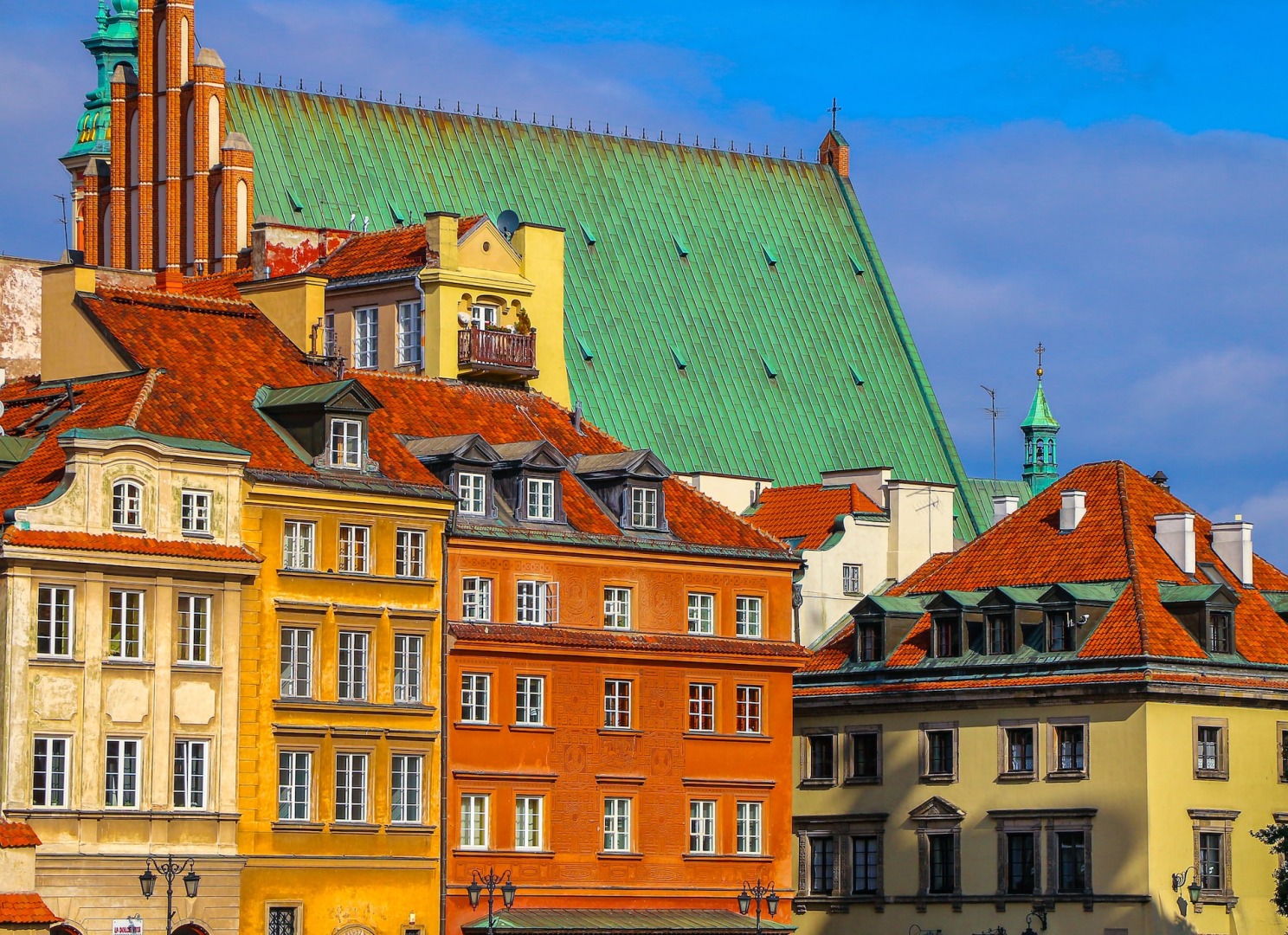
In 1939, Poland was invaded on both sides: by Germany from the west and by the Soviet Union from the East.
Germany controlled Poland during much of World War II, but with Germany’s defeat, the Soviet Union stepped in and established control of both its politics and economy. Although Soviet control was shaken at various times, including by the Solidarity labor movement in the 1980s, Poland did not recover its full autonomy until the 1990s. Thus, Poland experienced about five decades of a primarily planned economy, now followed by three decades of a primarily market-oriented economy.
What does this natural experiment show? It’s worth remembering that the promise of government economic control, then and now, is that it will ultimately make people better off. By the 1980s, after five decades of a planned economy, that promise had clearly failed in Poland. But after three decades of market orientation. In February, the UK opposition leader Keir Starmer caused a stir by noting that on trends estimated by the World Bank, Poland was on a pace to surpass the United Kingdom in per capita income by 2030.
For an overview of the Polish economic experience, a useful starting point is The Road to Socialism and Back: An Economic History of Poland, 1939–2019, by Peter J. Boettke, Konstantin Zhukov, Matthew Mitchell (June 2023, published by the Fraser Institute. Here, I’ll first share some graphs that give away the plot of what has happened.
Here’s a picture of trends in per capita GDP. The dashed blue line projects the trend in per capita GDP from 1970 up through 1992. The darker dashed line shows the trend since 1992–more than double where it was projected to be.
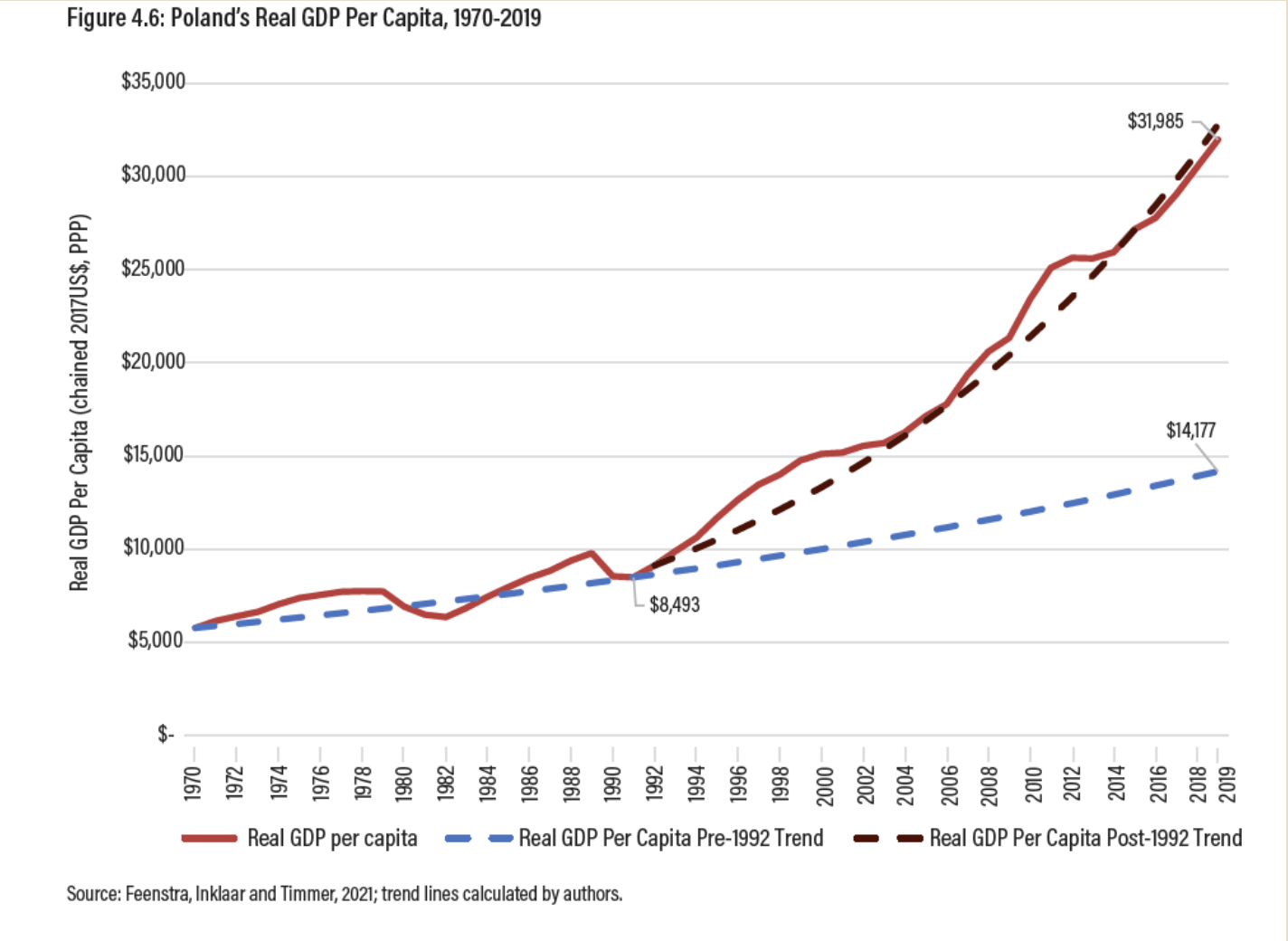
Here’s a graph comparing unemployment rates in Poland to some other nearby countries and to the average of OECD countries.
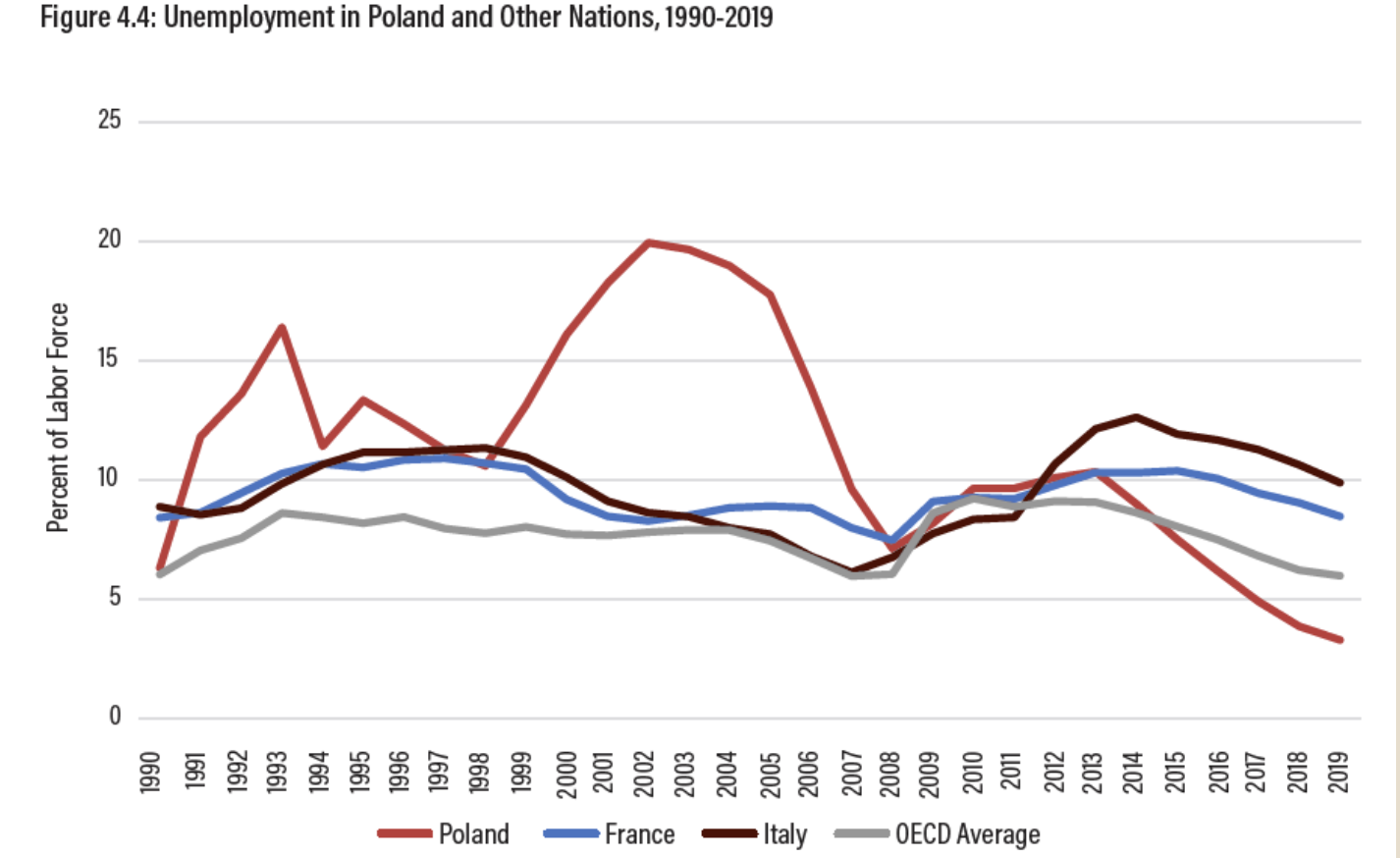
Other measures of well-being have improved dramatically as well. For example, here’s life expectancy at birth. The gray dashed line shows the trajectory that Poland was on. The rest of the figure shows Poland catching up to the OECD average.
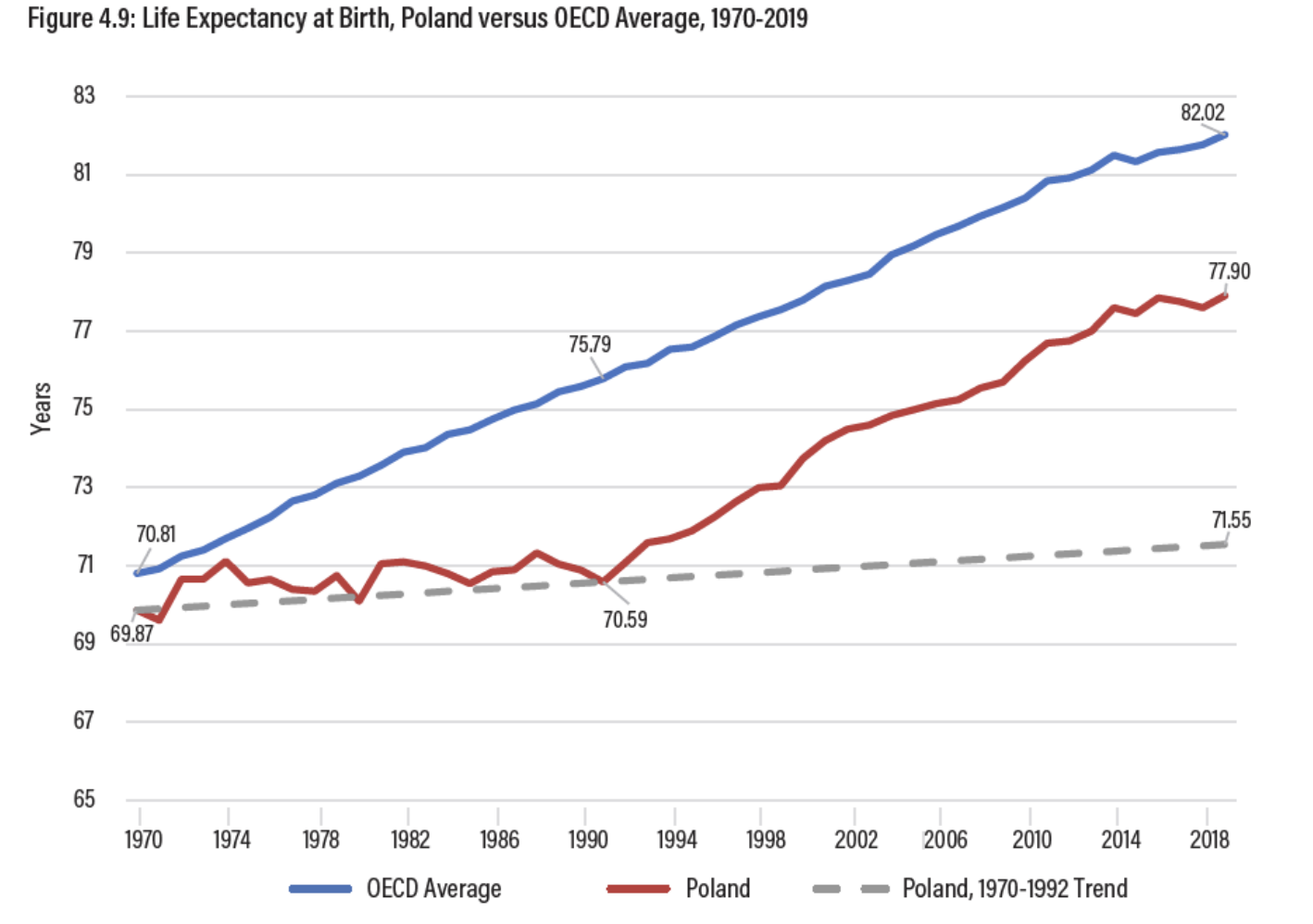
But doesn’t the transition to a market orientation generate much more inequality? Back in the 1990s, the answer was probably “yes.” But income is now more equal in Poland than the OECD average.
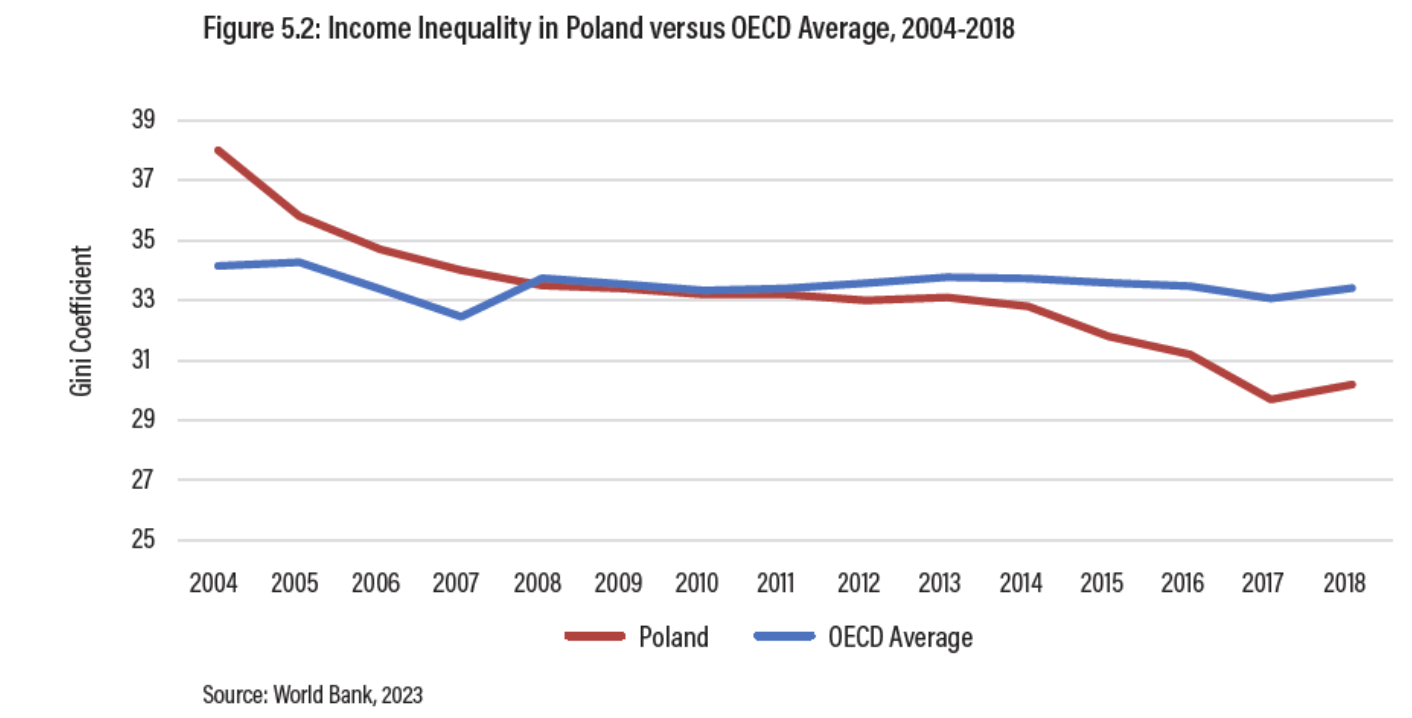
When it comes to poverty down to “social expenditures”–pensions, disability, and support for the poor–Poland’s spending (as a share of GDP) is similar to the OECD and roughly twice as high as it was during the planned economy era (and remember, per capita GDP was much lower at that time, too).
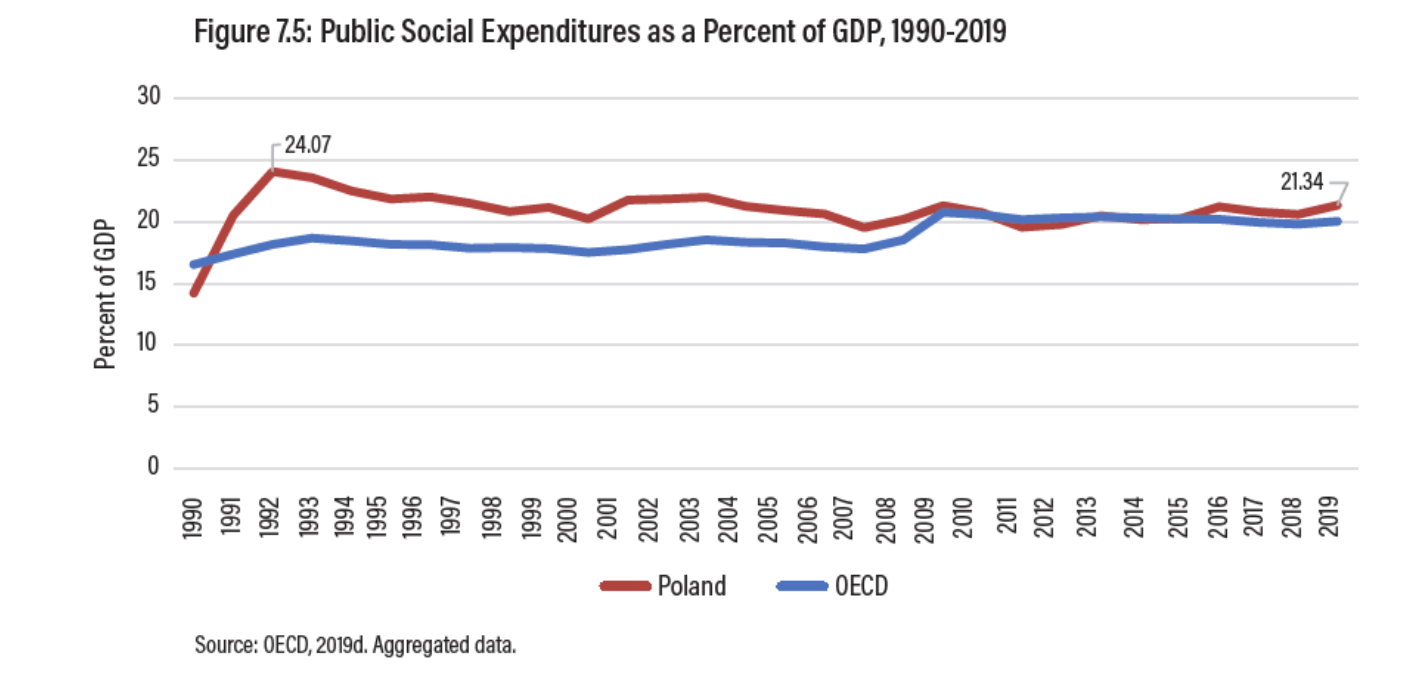
I’m of course not trying to pretend that Poland is without its problems or that it has become a heaven on earth. But looking at the broader picture, the standard of living of the Polish people was barely creeping upward during the time of the planned economy, and now has made dramatic gains.
The report from Boettke, Zhukov, and Mitchell goes through considerably more detail over the decades: the nationalization of Poland’s economy after World War II how the planned economy functioned, the pushback on planning at various times from different sectors, the rise of Solidarity in the 1980s, the “shock therapy” reforms of the 1990s, and ongoing issues like improving the current education and health systems in Poland. Here, I’ll just mention a few points that jumped out at me.
1) In some ways, the essence of the planned economy was a claim that if the market economy was allowed to do what it wanted, people would ultimately end up worse off. If consumers were allowed free rein, the argument went, they would fail to save and instead would spend on frivolities. Thus, for the economy to grow, consumers needed to be pressured or required to save, and then the government would direct these savings to investment in what it viewed as the important industries for development like coal, steel, and electricity.
With government planners making the economic decisions, Poland’s heavy industries did expand, but were perpetually inefficient. In addition, decades of de-emphasizing what consumers wanted took their toll. By the 1980s, the waiting list for houses was 15-30 years. “In the early 1970s, for every 100 telephone subscribers in Poland, there were another 34 people waiting for service. By the 1980s, there were 57 Poles waiting for service for every 100 subscribers.” Transactions for consumer goods often involved trading vodka, chocolate, or even toothpaste, or getting in line at a certain hour day after day, hoping to be allowed to purchase an appliance.
2) Not only did the government’s version of growth override what consumers wanted, it was deeply concerned that workers wouldn’t try hard enough. Thus, in the late 1940s and into the 1950s, the required work-week rose from 40 to 46 hours, and “social parasites” who didn’t work hard enough could be sentenced to two years of compulsory labor at any location the government designated.
3) The push for industrialization didn’t only ignore what consumers wanted, it also ignored environmental concerns. Here’s one example of the results:
The socialist record of pollution was notorious and industrial pollution in Poland was especially bad. A 1991 article in the Washington Post described Warsaw’s tap water this way: “It spurts yellowish-brown from the tap, laced with heavy metals, coalmine salts and organic carcinogens. It stains the sink, tastes soapy and smells like a wet sock that has been fished out of a heavily chlorinated swimming pool” (Harden, 1991). The same article reported that Warsaw tap water had double the World Health Organization’s limits on chloroform concentration; a quarter of Poland’s big industrial plants had either no waste-water treatment or used treatment devices with insufficient capacity; 57 percent of the Vistula river was classified as unfit for any purpose and the average concentration of mercury was nine times greater than the Polish norm for safe drinking water (Harden,
1991).
4) In the 1990s, Poland followed what was called the “shock therapy” approach to transitioning away from the planned economy. There was a considerable controversy over time over whether it was better to do such transitions quickly or more slowly. Remember, the transition involves many steps: market-determined prices, wages, interest rates, and exchange rates; shifting firms to private ownership, opening to trade with countries outside the former Soviet bloc; implementing a tax code; and much more. The immediate disruption in Poland was extreme: for example, inflation hits 250% one year.
But even as the previously favored heavy industries took a big hit as their government support was withdrawn, other industries that had been disfavored like food processing, passenger cars, home appliances, and consumer tech expanded dramatically. Looking back, it seems hard to make the case that if Poland had torn off the planned economy band-aids more slowly, the outcomes would have been substantially better.
5) A word of warning for the unwary: A substantial part of the discussion in the report is a review of the theoretical arguments for why planned economic socialism doesn’t work well. Personally, I’m always happy for a ramble through Marx and Hayek, Kornai and Mancur Olsen, and so on and so on. But shockingly enough, my tastes are not universal.
For those who believe that a combination of markets, flexible prices, and private property can and should play a prominent and useful role in societies, the experience of Poland will only tend to reinforce earlier beliefs. But of course, many are also dubious about markets. In my experience, this group is quick to admit that the Soviet style of planned economy did not work well. But they often cling to the idea that a different and better version of a planned economy would work better–often citing various European economies as a model. In my own view, there are lots of flavors of capitalism: American, Canadian, British, Japanese, German, northern European, southern European, and others. I’m open to a number of arguments about what the different versions of capitalism might learn from each other. But all of these countries primarily build their standard of living not on government planning, but on the dynamics of market economy.
Timothy Taylor is an American economist. He is managing editor of the Journal of Economic Perspectives, a quarterly academic journal produced at Macalester College and published by the American Economic Association. Taylor received his Bachelor of Arts degree from Haverford College and a master's degree in economics from Stanford University. At Stanford, he was winner of the award for excellent teaching in a large class (more than 30 students) given by the Associated Students of Stanford University. At Minnesota, he was named a Distinguished Lecturer by the Department of Economics and voted Teacher of the Year by the master's degree students at the Hubert H. Humphrey Institute of Public Affairs. Taylor has been a guest speaker for groups of teachers of high school economics, visiting diplomats from eastern Europe, talk-radio shows, and community groups. From 1989 to 1997, Professor Taylor wrote an economics opinion column for the San Jose Mercury-News. He has published multiple lectures on economics through The Teaching Company. With Rudolph Penner and Isabel Sawhill, he is co-author of Updating America's Social Contract (2000), whose first chapter provided an early radical centrist perspective, "An Agenda for the Radical Middle". Taylor is also the author of The Instant Economist: Everything You Need to Know About How the Economy Works, published by the Penguin Group in 2012. The fourth edition of Taylor's Principles of Economics textbook was published by Textbook Media in 2017.
Leave your comments
Post comment as a guest